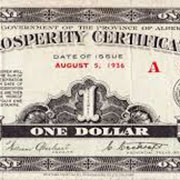CANADA HISTORY
Alberta and Bible Bill

William Aberhart, known as "Bible Bill," was a pivotal figure in Alberta's political and social history during the Great Depression. Born in 1878, Aberhart pursued two main passions throughout his life: education and religion. His career as an educator led him to become the principal of one of Calgary’s largest high schools, but it was his work as a preacher and radio personality that gave him a wide-reaching influence. Through his Prophetic Bible Institute and weekly radio broadcasts, Aberhart built a loyal following in Alberta, becoming one of the most recognized voices of his time. By the early 1930s, his radio sermons attracted more listeners than the popular Jack Benny Show that aired afterward, showing his reach and influence during a time of widespread social and economic turmoil.
The Great Depression profoundly affected Alberta, as it did much of Canada. Economic collapse, widespread poverty, and unemployment left people desperate for solutions. Traditional economic systems, particularly capitalism, appeared to be failing, and people across the country were searching for alternatives. The Depression spurred a return to faith for many as they sought answers in religion, but it also created an openness to new political ideologies. In Quebec, for example, the rise of Union Nationale displaced the Conservative Party and took power. In Alberta, the conditions were ripe for a similar transformation, and Aberhart found himself at the forefront of that change.
In 1932, Aberhart came across the economic theories of Major C.H. Douglas, who had formulated the concept of Social Credit. Douglas argued that economic slowdowns were the result of a shortage of currency in circulation. In his view, production was outstripping consumption because consumers did not have enough money to buy goods. Aberhart found this theory compelling and began to explore its relevance to Alberta, which was rich in resources, food, and housing, but lacked the money to stimulate economic exchange. His solution was to introduce more currency—either in the form of government-issued money or "script"—to restart the economy by giving every person in Alberta $25 a month to encourage spending and stimulate production.
Aberhart initially believed that he could promote Social Credit through his radio sermons and church, but he soon realized that direct political action was necessary. He tried to convince the governing party, the United Farmers of Alberta (UFA), to adopt his ideas, but they refused. Undeterred, Aberhart decided to form his own political party, the Social Credit Party, and ran against the UFA in the 1935 provincial election. His timing could not have been better. The UFA government, already struggling under the weight of the Depression, had been further weakened by scandals involving Premier John Brownlee and his finance minister, both of whom were accused of personal misconduct. Aberhart seized the opportunity, railing against the sin and corruption of the government, while promising to deliver the economic relief that Alberta so desperately needed.
On August 22, 1935, Aberhart’s Social Credit Party won a stunning victory, securing 56 of 63 seats in the Alberta legislature. Despite not running in the election, Aberhart was elected in a by-election shortly afterward and took his seat as the new Premier of Alberta. His ascension to power marked the first time in Canadian history that a government based on Social Credit principles took control of a province.
Once in office, Aberhart immediately set out to implement his economic vision. His government began issuing "Prosperity Certificates", a form of script designed to boost economic activity. However, these measures quickly encountered legal challenges. The courts ruled that monetary policy was a federal jurisdiction, meaning Alberta did not have the authority to issue its own currency. Despite these setbacks, Aberhart remained popular among Albertans, largely because his policies, though controversial, gave people hope during a time of despair. His moral leadership as a devout Christian also helped him retain the trust of the population, even as his economic plans faltered.
Aberhart's tenure as Premier came to an end with his death in 1943, but his influence on Alberta politics did not die with him. His successor, Ernest Manning, carried on the Social Credit movement, ensuring its dominance in Alberta for several more decades. The Social Credit Party remained in power in Alberta until the 1970s, and the movement even spread to British Columbia, where it held sway until the 1990s.
The importance of William Aberhart and the Social Credit movement in Canadian history cannot be overstated. Aberhart’s rise to power during the Depression exemplified the willingness of Canadians to explore alternative economic models in times of crisis. His success reflected a broader dissatisfaction with traditional political and economic systems and highlighted the role of charismatic leadership in bringing about political change. Moreover, his use of radio as a tool to reach and mobilize the public was innovative for its time, setting the stage for future political figures to use media as a way to influence public opinion.
Though Social Credit economics ultimately failed to take hold as a practical solution to Alberta’s economic woes, Aberhart’s movement left a lasting political legacy in Canada. His push for Alberta to assert control over its monetary policy also foreshadowed later tensions between provincial and federal powers in Canada, a theme that has continued to shape Canadian political discourse.
In conclusion, William Aberhart’s leadership during the Great Depression was crucial in reshaping Alberta’s political landscape. His Social Credit Party provided an alternative to traditional political parties, and his leadership during one of Canada’s darkest economic periods gave hope to many. While his economic theories did not fully succeed, his legacy lives on in the history of Alberta and Canadian politics, demonstrating the enduring power of political innovation in times of crisis.
Cite Article : www.canadahistory.com/sections/documents




